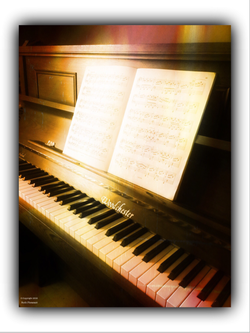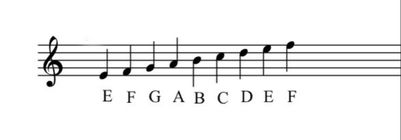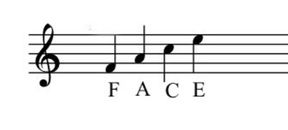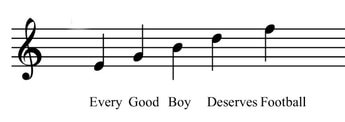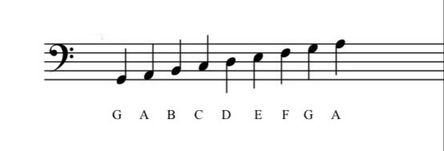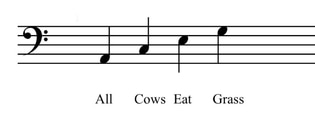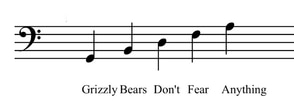Reading music is partly about recognising the positions of the note heads on the lines and spaces of the staff or staves, remembering the note names, and finding the corresponding notes on the musical instrument.
The illustration below shows the lines and spaces of the treble clef staff and their corresponding note names.
The illustration below shows the lines and spaces of the treble clef staff and their corresponding note names.
It is possible to use mnemonics to help remember the note names a bit more easily. For example if you take the notes in just the spaces of the treble clef staff you will see that their letter names spell "face".
The lines of the treble clef staff have the note names E G B D F.
A common way of remembering them is to create a phrase with each letter being the starting letter of each word in the phrase. A very popular phrase for remembering the treble clef lines is "every good boy deserves football".
A common way of remembering them is to create a phrase with each letter being the starting letter of each word in the phrase. A very popular phrase for remembering the treble clef lines is "every good boy deserves football".
We can do something similar with the bass clef notes. The next illustration shows the bass clef lines and spaces and their corresponding letter names.
A popular phrase for remembering the bass clef spaces is "all cows eat grass".
A popular one for the bass clef lines is "grizzly bears don't fear anything".
Another important aspect of reading music is spotting patterns and seeing shapes formed by sequences of notes. Eg. recognising when a sequence of notes is moving up or down, in steps or skipping notes.
The next illustration shows notes moving up then down in step. The corresponding sound on the instrument would be notes moving up one pitch each time then back down one each time.
The next illustration shows notes moving up then down in step. The corresponding sound on the instrument would be notes moving up one pitch each time then back down one each time.
The following illustration shows notes moving up in skips then back down in skips. This means that rather than moving from one note to the next, a note is being missed out. Skipping is notated by going from a space to the next space as shown by the first three notes, or a line to the next line as shown by the last three notes.
Articles main menu
You may also be interested in how to improve your sight reading on the piano or how to improvise on the piano.
You may also be interested in how to improve your sight reading on the piano or how to improvise on the piano.
